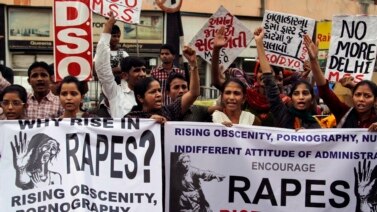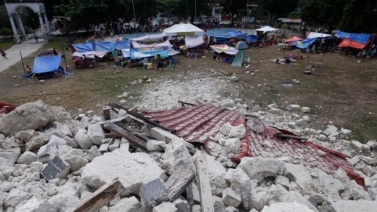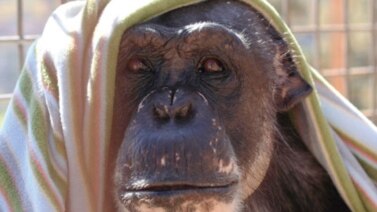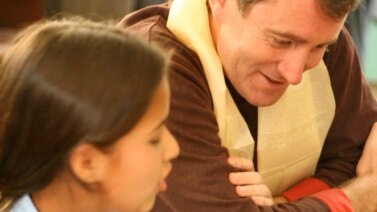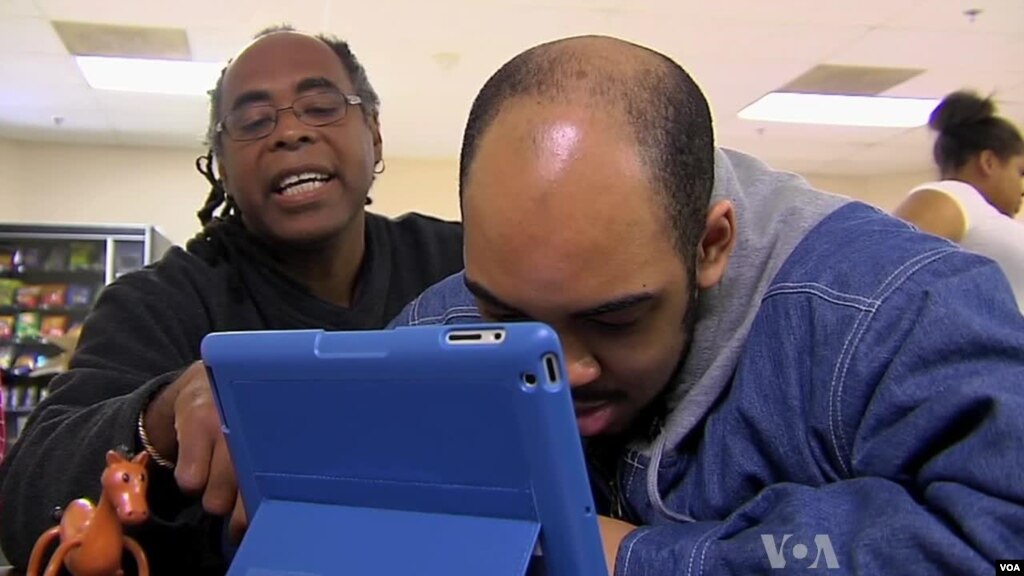
Hello there, I’m June Simms. Welcome back for more As It Is!
The United States has given birth to many types of music, including rock and roll, jazz, country and blues. Today we hear about the increasing popularity of hip-hop music and dance.
But first, we visit a workshop in Washington where disabled individuals are learning the art of filmmaking.
Filmmaking Classes Give the Disabled a Creative Outlet
Apple's popular tablet computer, the iPad, has changed filmmaking by providing a creative and moderately low cost way for people to express themselves. VOA’s Faiza Elmasry says the iPad has done even more for a group of disabled individuals near Washington, D.C. Katherine Cole has her report.
A group of people with physical and intellectual disabilities goes to a daycare center two times a week and become filmmakers. In a class, they learn to use iPads to shoot and edit video, with help from employees of the center and skilled filmmakers. The Creative Edge Studio is directing the filmmaking workshop.
On this day, Judy Turay is working with Nicole Chase.
“Good job. She communicates so well with me. She likes taking pictures of her friends.”
That in itself is a sign of progress for Melissa Ezelle, a project director of The Arc. The nonprofit support group provides services to the disabled. It began offering the filmmaking workshops earlier this year.
“The philosophy of this particular partnership, the Creative Edge Digital Media Partnership is to introduce iPads to our individuals with disability so they can use them as communication tools, but also as tools to creatively express themselves through photography or through i-movie.”
Filmmaker Andrew Millington works for the Creative Edge Studio. At first, he taught the class the basics -- things like image capturing, editing and how to put things in order. Now, he cheers them on as they use those skills to create stories of their own.
Michael Steele brought in toys to be the characters in his film.
“Bunnies, pigs, horses and robots.”
“It may not be the Hollywood strict form of expression, “A” follows “B” follows “C”, so on, but I wish I could tell a story with that freedom, with that purity of expression.”
Filmmaking is part of The Arc’s holistic method of helping people with intellectual and developmental disabilities become more active in their communities. The next step, says Jessica Neely, its director of family services, will be letting them go out with their iPads to document what they see.
“The goal is to sort of move the whole model of an adult day center out from the four walls of the center and into the community.”
Andrew Millington has another goal for the films his students create.
“I’m hoping that eventually the standard reaches a point where we can screen them for audiences.”
That would familiarize those audiences to the hopes and skills of a community that is too often unseen. I’m Katherine Cole.
And I’m June Simms. You are listening to As It Is from VOA Learning English.
(MUSIC)
Hip-Hop Music and Dance Gaining in Popularity
Young African-Americans in New York are credited with developing hip-hop music and dance more than 40 years ago. Since then, hip-hop culture has become increasingly popular throughout the country and the world. Today, we hear how hip-hop or urban dance has found a new audience among Asian-Americans in Southern California.
Michelle Salazar says something magical happens when these dancers move their bodies. They could be dancing freestyle in a cypher or dance circle, or performing a carefully choreographed routine.
“My first mentor, he said dancing is like touching the face of God. That’s just how I feel.”
Philippine-American Arnel Calvario is one of the first Asian-American urban dancers to gain popularity. He grew up in the 1970s and '80s. He saw other Filipinos as well as African-Americans and Latinos dancing in the streets of his neighborhood in Southern California. In junior high school, he says, he surprised some African-American girls who saw him dance.
“They’d verbally say that 'I’ve never seen an Asian guy dance like that,' you know. And that was a pivotal moment for me. In one sense you can be kind of offended by that. I felt like oh I need to do something about that.”
In college, in the early 1990s, Calvario included this uniquely American dance form in a Philippine cultural show. He formed the dance company Kaba Modern. Soon, more Asian-American dance companies began forming at universities in Southern California.
“It quickly spread to the Chinese associations, the Japanese, Vietnamese. So it was a really interesting time because, within a year, it spread so fast.”
Lorenzo Perillo is teaching a class in hip-hop dance at Cornell University this fall.
“It’s kind of like something that is seen as foreign to a particular culture and saying no, it’s not foreign, it’s actually something that we all do, we just don’t consider it; we just haven’t shifted our paradigm yet.”
African-American dancer Dineytra Lee says her ideas about urban dance shifted after she auditioned for a hip-hop dance crew.
“And I go to the audition and I see nothing but Asians and I’m like, 'What’s going on here.' But it was just literally a legitimate culture shock.”
What Asian-Americans saw in their community for years was not represented on television. Now Asian-American urban dancers are a large part of many of these dance competition shows.
“It was never so prominent as it is now. Now we’re all over. And in these dance shows we dominate.”
With social media, hip-hop dance no longer seems to belong to any particular group. It has spread globally with dancers around the world expressing themselves through this form of movement.
And that is As It Is for day. Thanks for listening.
For questions or comments about our show, email us at learningenglish@voanews.com.
And stay here for VOA world news, coming up at the beginning of the hour, Universal Time.
Have a great weekend!

